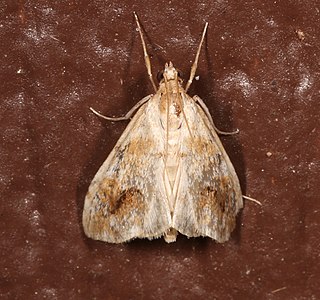Chrismania is a monotypic moth genus of the family Crambidae. Its only species, Chrismania pictipennalis, is found in North America, where it has been recorded from southern California and Arizona. Both the genus and species were first described by William Barnes and James Halliday McDunnough in 1914.

Evergestis is a genus of moths of the family Crambidae described by Jacob Hübner in 1825. A number of species are pests, including the cross-striped cabbageworm, a pest of cole crops such as cabbage.
Evergestis angustalis is a moth in the family Crambidae. It was described by William Barnes and James Halliday McDunnough in 1918. It is found in North America, where it has been recorded from California and Arizona.
Evergestis aridalis is a moth in the family Crambidae. It was described by William Barnes and James Halliday McDunnough in 1914. It is found in North America, where it has been recorded from California and Nevada.
Evergestis eurekalis is a moth in the family Crambidae. It was described by William Barnes and James Halliday McDunnough in 1914. It is found in North America, where it has been recorded from Arizona, California and Utah.
Evergestis funalis is a moth in the family Crambidae. It was described by Augustus Radcliffe Grote in 1878. It is found in North America, where it has been recorded from Alaska, Arizona, British Columbia, California, Colorado, Nevada, Oregon, Utah and Washington.

Evergestis lunulalis is a moth in the family Crambidae. It was described by William Barnes and James Halliday McDunnough in 1914. It is found in North America, where it has been recorded from Arizona, New Mexico and Texas.
Evergestis subterminalis is a moth in the family Crambidae. It was described by William Barnes and James Halliday McDunnough in 1914. It is found in western North America, where it has been recorded from west central Alberta south to Colorado, Utah and California. The habitat consists of montane meadows.
Evergestis triangulalis is a moth in the family Crambidae. It was described by William Barnes and James Halliday McDunnough in 1914. It is found in North America, where it has been recorded from Arizona, Nevada and New Mexico.
Hellula aqualis is a moth in the family Crambidae. It was described by William Barnes and James Halliday McDunnough in 1914. It is found in North America, where it has been recorded from Arizona, California, Colorado, Nevada, New Mexico and Texas.
Loxostege quaestoralis is a moth in the family Crambidae. It was described by William Barnes and James Halliday McDunnough in 1914. It is found in North America, where it has been recorded from California to New Mexico.
Loxostege typhonalis is a moth in the family Crambidae. It was described by William Barnes and James Halliday McDunnough in 1914. It is found in North America, where it has been recorded from Arizona and New Mexico.
Loxostege unicoloralis is a moth in the family Crambidae. It was described by William Barnes and James Halliday McDunnough in 1914. It is found in North America, where it has been recorded from southeastern California and Arizona.
Pseudopyrausta santatalis is a moth in the family Crambidae. It was described by William Barnes and James Halliday McDunnough in 1914. It is found in the United States, where it has been recorded from southern Texas and Florida. It is also found in the West Indies and Mexico.

Eudonia spaldingalis is a moth in the family Crambidae. It was described by William Barnes and James Halliday McDunnough in 1912. It is found in North America, where it has been recorded from Alberta, Arizona, British Columbia, California, Colorado, Montana, Nevada, New Mexico, Utah and Wyoming.
Frechinia lutosalis is a moth in the family Crambidae. It was described by William Barnes and James Halliday McDunnough in 1914. It is found in North America, where it has been recorded from Arizona, Colorado and New Mexico.
Noctueliopsis pandoralis is a moth in the family Crambidae. It was described by William Barnes and James Halliday McDunnough in 1914. It is found in Mexico and the southern United States, where it has been recorded from New Mexico.
Apilocrocis brumalis is a moth in the family Crambidae. It was described by William Barnes and James Halliday McDunnough in 1914. It is found in Mexico and the southern United States, where it has been recorded from southern Texas.
Blepharomastix pseudoranalis is a species of moth in the family Crambidae first described by William Barnes and James Halliday McDunnough in 1914. It is found in North America, where it has been recorded from Arizona.
Choristostigma disputalis is a moth in the family Crambidae. It was described by William Barnes and James Halliday McDunnough in 1917. It is found in North America, where it has been recorded from Alberta, Arizona, British Columbia, California and Oregon.


